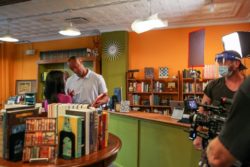
Lights, Camera, Safety!
With safety foremost in everyone’s minds, 2020 has required a great deal of adaption for us all. The Hatcher Group video team is no exception. Since the start of the pandemic, we’ve been working to develop innovative ways to produce high-quality videos in-house – but remotely. Whether shipping DIY video kits that include a tripod, lavalier mic, and a small LED light, or using cell phone footage combined with exciting motion graphics elements, we’ve had great success creating pieces that inspire people to act.
Hatcher is also back to some in-person video production with advanced safety protocols in place. During the summer, working with a production partner, Hatcher produced and filmed an on-location television commercial for a Maryland-based client. The commercial is scheduled to air regionally before the end of the year. While the process felt familiar, filming amidst an ongoing pandemic meant new rules and different ways to do things for all of us. Shooting a commercial with a full crew, talent, and multiple locations (some indoors) elevated the need for a comprehensive plan with the most stringent safety protocols. From that experience, we can recommend a few best practices for your next in-person video shoot.
- Create a Safety Plan. First and foremost, take the time to familiarize yourself with state and local restrictions and CDC and OSHA safety guidelines. Based on those guidelines, develop an action plan to minimize risk for your crew, talent, and community. Having a comprehensive plan – based on health experts’ recommendations – is the most critical part of your pre-production work.
- Collaborate with Partners You Trust. Team up with production partners you know from experience will bring a high level of professionalism to the set. It only takes one person’s actions to derail a shoot or endanger the health of others, so work with people who are on the same page. For our shoot, we partnered with RaffertyWeiss Media, a firm we know and trust to deliver a high-quality product and adhere to strict safety standards.
- Consider Casting Caveats. Casting talent was our greatest challenge to overcome. We had to carefully consider how best to cast the families (including several children) in our concept and block them in each scene. Ultimately, it made the most sense to cast actors who were members of the same household. Casting real families reduced the risk of additional exposure and made pre-filming safety checks more reliable. When families aren’t part of your scene, have conversations with the actors to convey the safety protocols and confirm people’s cooperation before showing up to the shoot.
- Invest in a Compliance Health Professional. For this shoot, the crew had a new addition: a COVID compliance nurse. The licensed nurse’s sole responsibility was to ensure all shoot participants’ safety, from the cast and crew to craft services and location owners. They enforced mask-wearing and use of PPE (masks were mandatory and anyone working directly with talent was required to use a face shield), social distancing, and, importantly, frequent sanitizing as dictated by the CDC and state of Maryland guidelines. The COVID nurse prepped and cleaned each indoor location before any crew set up and evaluated each commercial interior’s safety, ensuring that social distancing could be maintained while on site. The nurse also took each person’s temperature and performed a verbal screening before allowing anyone on site. Having the compliance nurse on set gave the cast and crew peace of mind, freeing up mental space to focus on our jobs.
- Maximize Distance, Minimize Exposure. We actively limited the number of people allowed on set and the duration of shoots to minimize exposure during filming. If a crew member wasn’t needed, we asked them to wait outside. We also utilized alternate shot set-ups, camera angles, and lenses to allow for greater distance between actors. Finally, whenever possible, we filmed outdoors for increased air circulation.

Photo by The Hatcher Group
The production world has adapted with thoughtfulness and creativity to the challenges that COVID-19 has presented. Many freelancers and production companies – big and small – were happy to share the precautions they took to get back to work safely and their lessons learned from being back in the field. Their generosity cut through some of the anxiety, reinforced our love of the production community, and helped us build our own safety guidelines for filming in the time of COVID. All of Hatcher’s production team members are Safe Sets certified, arrive at filming locations in separate cars, and have become experts at talking talent through the best way to put on a lavalier microphone from 6 feet away.
By being flexible and adapting, we’ve fostered honest conversations with our clients about the different forms our video deliverables can take – beyond the typical on-location shoot. To meet our clients where they are — in their homes, mostly — we’ve excelled at reimagining alternative approaches to telling their stories. This has increased our capacity to produce videos for anyone from anywhere and at any client’s budget. Although we can’t wait to be back out in the field regularly, for now, we look forward to finding the smartest approach for our clients’ video communication goals, remotely or in person!
By Melissa Rogers, Senior Video Producer and Jenny Beard, Senior Director, Events